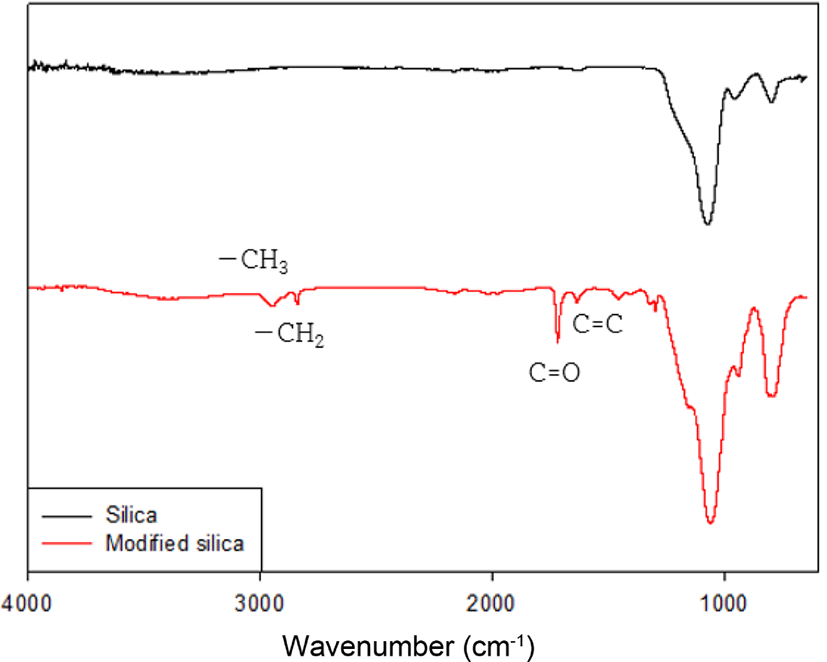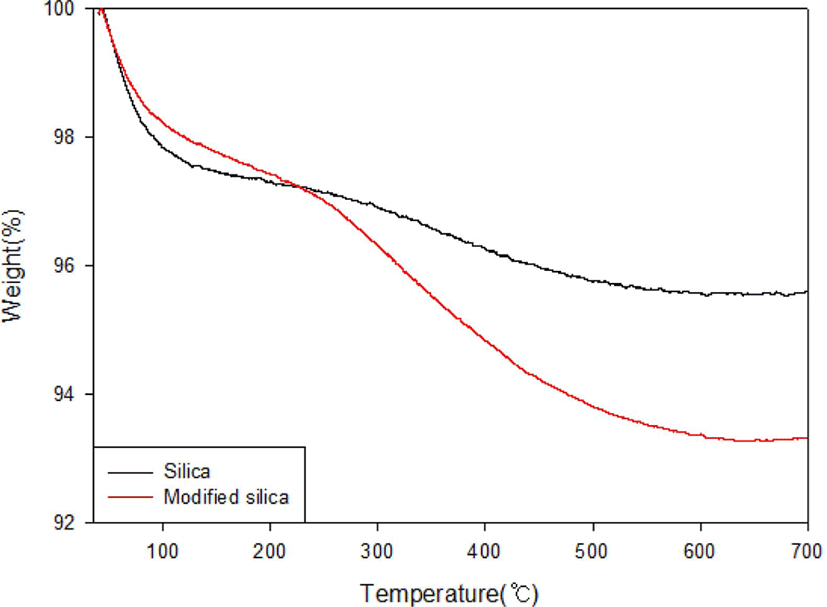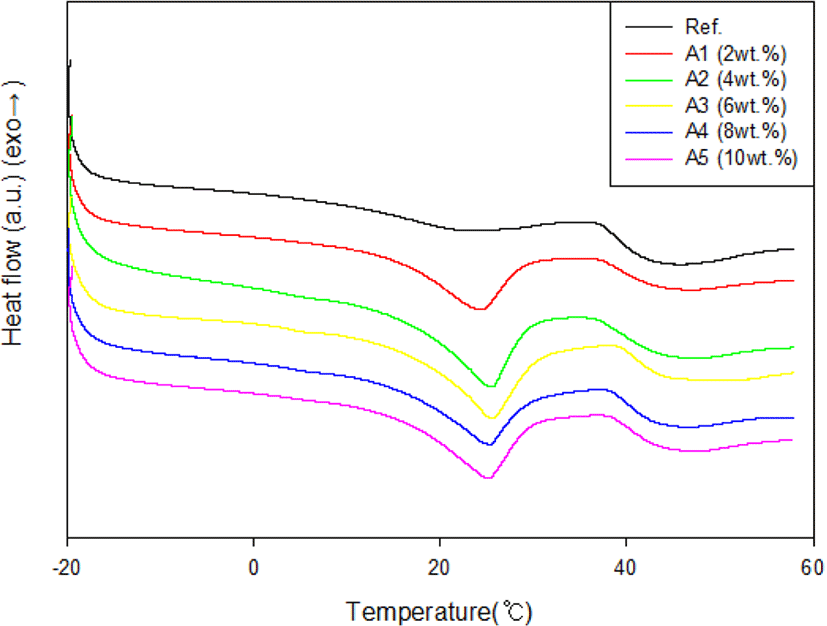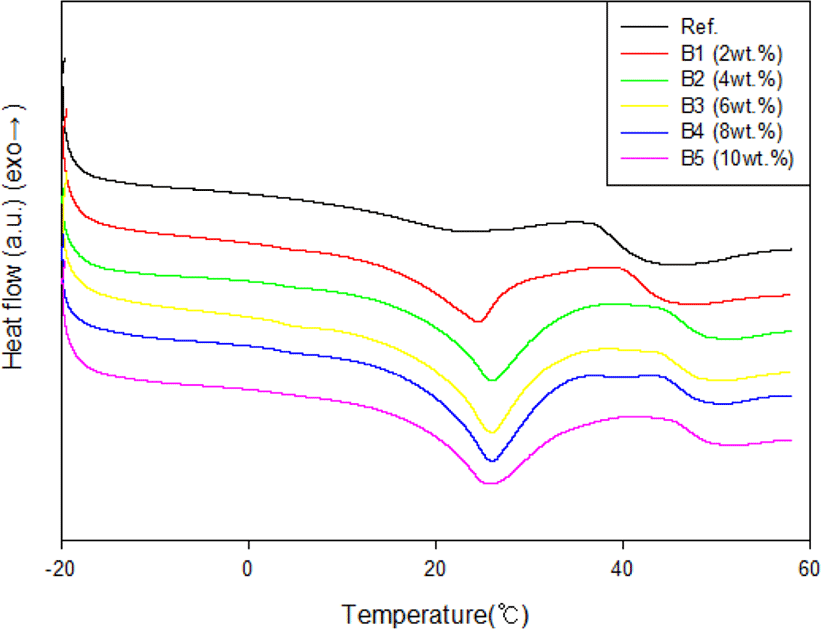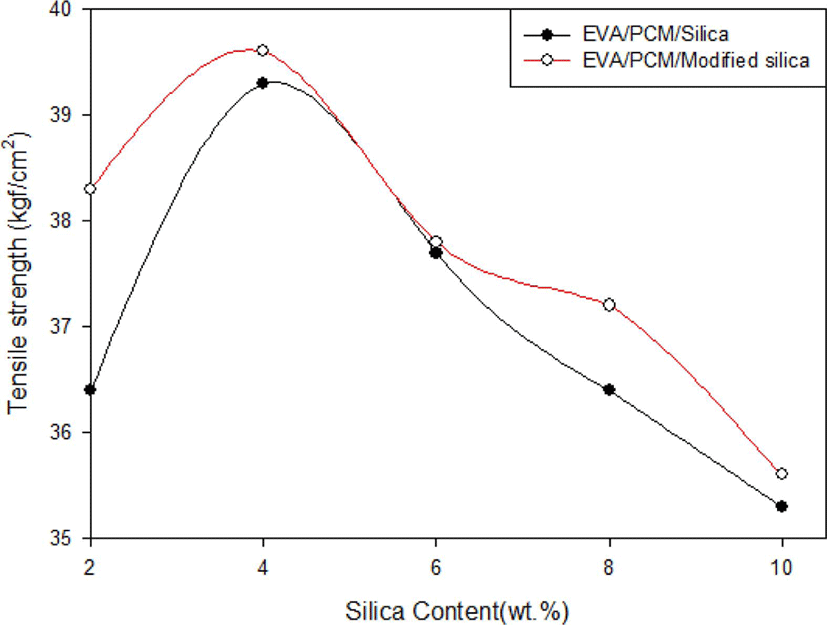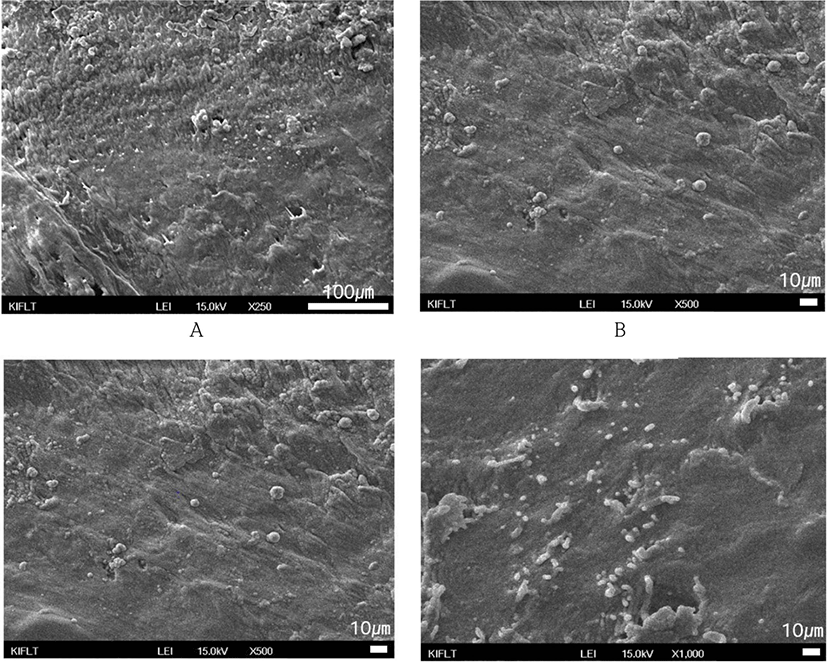Introduction
상전이 물질(Phase Change Material, PCM)은 일반적으로 고체-액체 간 상이 변하면서 외부로부터의 열을 흡수하거나 내부의 열을 방출하여 열전달을 지연할 수 있는 성능이 큰 물질로써 건축자재 및 냉난방 시스템 등에 적용하여 냉난방에 사용되는 에너지를 절감할 수 있다.1–5 이런 분야에 상전이 물질을 응용하면 이산화탄소 발생을 줄일 수 있어 환경 보전에도 기여한다. 따라서 PCM은 에너지를 절약하는데, 필수적인 친환경 소재로 손꼽히고 있다.
이에 학계에서도 PCM을 이용하여 에너지 절약에 대한 연구가 활발히 이루어지고 있다. 건축학에선 PCM을 시멘트와 혼합하여 열효율을 높이는 실험과 펠렛 형태의 PCM을 단열재와 혼합, 외벽에 설치한 후 자연 기후 조건에서 현장 테스트한 실험이 진행되었으며,4–6PCM으로 채워진 열저장 장치(HSU)를 사용하여 PDA(personal digital assistant) 및 웨어러블 컴퓨터와 같은 모바일 전자 장치의 냉각에 대한 실험 연구가 수행되었다.3
PCM이 에너지를 저장하고 방출하기 위해서는 상전이 할 때 밀도(부피)변화가 크므로 일정한 공간이 필요한데, PCM을 고분자 첨가제로 사용하면 고분자 내에서 구속돼 상전이 할 공간이 없어 에너지 흡수 및 방출할 성능이 현저히 떨어지게 된다. PCM을 첨가제용으로 사용하기 위해서, 유화 중합으로 PCM을 벽재로 감싸는 캡슐화법(encapsulation)이 이용되고 있는데 이와 같은 PCM 캡슐은 페인트와 같은 액상에 첨가되어 사용되고 있다. 이와 같은 상전이 공간을 가진 PCM 캡슐은 고분자 첨가제용으로 사용될 것 같지만, 가공(혼합) 중에 발생되는 마찰, 압력 및 전단력에 의해 캡슐이 쉽게 파괴되어 캡슐로 부여한 공간 효과가 매우 낮아진다. 또한, 파괴된 캡슐 속의 상전이 물질은 고분자 표면으로 migration 된다. 이를 해결하기 위하여 이중 셀 형성 캡슐화를 하거나1 레진으로 캡슐 표면을 코팅 시킨 연구가 진행되었다.2
본 연구에서는 EVA/PCM compound에 silica를 사용하여 상전이 할 수 있는 공간을 부여하고, silica 첨가되지 않은 reference compound와 열용량을 비교하였으며 EVA와 PCM 간 상용성을 개선하기 위하여 porous silica를 3-methacryloxypropyltri-methoxysilane으로 5 wt% 표면 건식 개질시킨 modified silica를 제조, 첨가하여 compound를 제작, silica compound와 비교 평가하였다.7,8 FT-IR, TGA 분석을 통해 modified silica 표면개질유무를 확인하였으며, compound의 열용량은 DSC 분석, compound의 물리적 특성을 알아보기 위하여 기계적 강도를 평가하였으며 SEM을 이용하여 compound의 모폴러지를 평가하였다.
Experimental
Compound 제조를 위해 사용된 다공성 재료는 pore size 19.4 nm, surface area 184 m2/g을 갖는precipitated silica (Zeosil175, Rhodia Solvay, Belgium)를 사용하였고 실란커플링제로는 메타크릴기(-methacryloxy)를 갖는 3-methacryloxy-propyltrimethoxysilane (KBM503, ShinEtsu, Japan) 사용하였으며, 고분자 수지는 EVA (EVA1317, Hanwha solutions, Korea), PCM으로는 석유계 파라핀(RT24, Rubitherm, Germany)을 사용하였다.
본 실험에선 친수성기인 -OH기를 갖는 다공성 재료 silica 표면을 실란커플링제인 3-methacryloxypropyltrimethoxysilane으로 소수성 표면개질하여 PCM과의 상용성을 개선하는 건식 개질 공정으로, 120°C로 세팅되어 있는 고속교반기에 silica 투입한 후 100 rpm으로 교반 유지하면서 silica 고형분 대비 5 wt% 실란커플링제를 12 g/min의 속도로 drop한 후, 300 rpm으로 3 min, 10 rpm으로 10 min 교반하여 표면개질하였다.
EVA/PCM/Silica compound 제조 전 과정으로silica를 120°C의 dry oven에서 3시간 이상 건조 후 수분 함량 1% 미만임을 확인 후, dry oven내에서 상온까지 냉각시켜 사용하였으며 PCM은 60°C의 dry ov-en에서 12시간 액화를 시킨 후 사용하였다. EVA와 PCM을 70:30의 중량비로 배합함에 있어, 200 ml knead-er에서 EVA 70g 투입 후 120 rpm으로 15분간 80°C 이상으로 충분히 혼련하고, PCM과 porous silica를 동시 투입, 20 rpm, 30분간 혼련하여 EVA/PCM/Silica compound 제조한 후 6inch roll-mill에서 약 1~2 mm 두께의 sheet로 만들었다.
| Ref. | A1 | A2 | A3 | A4 | A5 | |
|---|---|---|---|---|---|---|
| EVA | 70 | 70 | 70 | 70 | 70 | 70 |
| PCM | 30 | 30 | 30 | 30 | 30 | 30 |
| Silica | 0 | 2 | 4 | 6 | 8 | 10 |
| Ref. | B1 | B2 | B3 | B4 | B5 | |
|---|---|---|---|---|---|---|
| EVA | 70 | 70 | 70 | 70 | 70 | 70 |
| PCM | 30 | 30 | 30 | 30 | 30 | 30 |
| Modified silica | 0 | 2 | 4 | 6 | 8 | 10 |
Compound의 실리카 함량별 인장강도를 측정하기 위하여 만능재료시험기(M-130, Instron, USA)를 사용하였다. 인장강도는 ISO 527 규격에 준하여 100 mm/min의 시험 속도로 인장강도를 측정하였다. 함량별 길이 20 mm, 폭 5 mm의 아령형 시험편으로 제작, 3개를 시험하여 평균값을 사용하였다.
Compound 표면의 분산성을 관찰하기 위하여 전자주사현미경(S-4200, Hitach, Japan)으로 SEM 이미지를 촬영하였다.
| Ref. (0 wt%) | A1 (2 wt%) | A2 (4 wt%) | A3 (6 wt%) | A4 (8 wt%) | A5 (10 wt%) | |
|---|---|---|---|---|---|---|
| Heat capacity (J/g) | 9.38 | 24.88 | 30.02 | 31.27 | 29.26 | 21.74 |
| Ref. (0 wt%) | B1 (2 wt%) | B2 (4 wt%) | B3 (6 wt%) | B4 (8 wt%) | B5 (10 wt%) | |
|---|---|---|---|---|---|---|
| Heat capacity (J/g) | 9.38 | 26.59 | 32.37 | 39.63 | 32.39 | 29.26 |
Results and Discussion
실란커플링제인 3-methacryloxypropyltrimethoxysilane을 이용하여 제조한 개질 실리카의 표면 개질을 확인하기 위해서 FT-IR 측정 결과를 Figure 4에 나타내었다. 미 개질 실리카의 경우 1,060 cm-1, 800 cm-1 위에서의 peak가 강하게 나타나며 이는 stretching of the Si-O-Si bonding의 stretching에 기인한 것으로 확인된다.
개질 실리카는 실란커플링제 3-methacryloxypropyltrimeth-oxysilane에서 나타난 2,946, 2,841, 1,718, 1,637 및 1,296 cm-1 에서 새로운 peak가 나타났다. 2,946, 2,841 cm-1 부근에서의 peak는 methacrylate기의 −CH3 및 −CH2에 기인하여 intensity가 증가함이 확인되었고, 1,718 및 1,637 cm-1 peak는 3-methacryloxypropyltrimethoxysilane에서 도입된 C=O 및 C=C 결합을 각각 나타낸다. methacrylate기의 −CH3 및 −CH2기의 도입과 C=O 및 C=C 결합의 생성을 통하여 개질의 진행을 확인하였다.
실란커플링제를 이용하여 제조한 개질 실리카의 표면개질유무를 확인하기 위해서 온도에 따른 개질 실리카의 무게 변화 TGA 측정 결과를 Figure 5에 나타내었다. TGA 그래프로 미 개질 실리카와 표면 개질 실리카의 온도에 따른 무게의 변화를 확인한 결과, 미 개질 실리카의 무게 변화는 97.31 → 95.61(%)로 감소되었고 30에서 100°C 사이의 무게감소는 H2O의 탈착으로 인한 무게 감소이며, 100에서 200oC 사이에서는 실리카 표면에 물리적 및 수소결합으로 흡착된 H2O의 탈착으로 인한 무게감소로 판단된다. 개질 실리카의 무게 변화는 97.50 → 93.27(%)로 감소로 미 개질 실리카의 감소 비율보다 큰 수치를 나타냈으며 30에서 100°C 사이의 무게감소는 실리카 표면의 미 반응 실란올의 탈착으로 인한 무게감소로 판단되며 200에서 700°C 사이에서는 실리카 표면의 친수성실란올기가 실란과 반응하여 소수성으로 변화한 methacryloxy기의 흡착되는 수분의 양의 감소를 나타낸다. 이를 통하여 실리카 표면에 개질의 진행을 확인하였으며 개질의 진행 정도는 2.53%였다.
Compound의 열 흡수 및 방출 특성을 알아보기 위해서 DSC 분석 결과를 나타내었다. 실리카 함량별 compound의 흡열량(Figure 6), 개질된 실리카를 첨가한 compound의 흡열량(Figure 7)을 확인하고자 silica의 함량을 0, 2, 4, 6, 8, 10 wt%로 변량하여 제조한 compound의 온도에 따른 흡열량을 측정한 결과 흡열량은 실리카 함량이 6 wt%로 증가할수록 상전이 온도가 높아지다 8 wt%에서 부터 낮아졌으며 이는 실리카 첨가양이 6 wt%가 되면 PCM이 실리카 내부로 흡착, 결정화된다고 판단되며 그 이상 첨가 시 실리카 표면에 PCM이 흡착되어 내부 결정화 진행은 어려워진다. 실리카 표면과 기공 내부의 PCM은 bulk한 상태의 PCM과 달리 표면 거칠기와 표면-PCM의 결합력, 기공 내, 외부의 온도 차, 압력 차로 인하여 결정화를 위한 핵생성과 PCM 확산이 방해받게 되므로 PCM이 결정화에 제한된다. 개질 실리카 첨가 시 함량이 증가할수록 흡열량이 증가하다가 6 wt% 시점에서 최대 흡열량을 보인 후 다시 낮아지는 경향성을 보였으며 개질 실리카를 사용함으로써 미개질 실리카를 사용한 컴파운드 대비 상전이 에너지가 향상된 결과를 얻을 수 있었다. 이는 실리카 표면 개질로 인하여 EVA와 PCM의 상용성이 증대되고 혼련 과정에서 표면에 존재하던 PCM이 실리카 기공 내부로 침투되기 용이했다고 판단된다.
실리카의 함량별 compound와 개질 실리카 함량별 compound의 인장강도와 연신율을 Figure 8, 9에 나타내었다. 실리카 4 wt% 첨가 시 최대값을 보이며 6 wt%부터 감소하는 경향을 보였다. 4 wt% 이상 첨가할 경우 PCM이 실리카 내부로 결정화를 못하고 실리카 표면에 흡착되어 EVA 입자와 PCM 입자가 혼련되는데 방해하는 잔여물로 존재하여 compound의 분산성을 떨어뜨려 인장강도의 저하를 초래하였다. 개질 실리카가 첨가된 compound 또한 유사한 경향성을 띄었는데 개선된 인장강도, 연신율 값을 나타내는 건 실리카 표면개질로 인하여 EVA와 PCM의 상용성이 증대되어 혼련과정에서 표면에 존재하던 PCM이 실리카 기공 내부로 침투되었기 때문으로 판단된다.
실리카의 함량별 compound와 개질 실리카 함량별 compound의 인열강도 그래프를 Figure 7에 나타내었다. 인장실험 결과와 마찬가지로 실리카 4 wt% 첨가 시 최대값을 보이며 6 wt%부터 감소하는 경향을 보였다. 개질 실리카가 첨가된 compound 또한 유사한 경향성을 띄었는데 약 8% 개선된 인열강도 값을 나타내었는데 실리카 표면개질로 인하여 EVA와 PCM의 상용성이 증대되어 혼련 과정에서 표면에 존재하던 PCM이 실리카 기공 내부로 침투되었기 때문으로 판단된다.9,10
Conclusions
본 연구에서는 EVA/PCM compound에 silica를 사용하여 상전이 할 수 있는 공간을 부여하고, EVA와 PCM 간 상용성을 개선하기 위하여 silica를 3-methacryloxypropyltrimethoxy-silane으로 5 wt% 표면개질시킨 modified silica를 제조, 첨가하여 compound를 제작, silica compound와 비교 평가하여 다음과 같은 결론을 내렸다. FT-IR, TGA 분석을 통해 modified silica 표면개질유무를 확인하였으며, 약 2.53% 개질 진행을 확인하였다. DSC분석을 통한 compound의 열용량은 실리카 및 개질 실리카 6 wt% 첨가된 compound에서 가장 높았으며 6 wt% 첨가 시 PCM이 실리카 내부로 결정화된다고 판단되며 그 이상 첨가 시 실리카 표면에 PCM이 흡착되어 내부 결정화 진행은 어려워진다. Compound의 기계적 평가를 통해 실리카 및 개질 실리카 4 wt% 첨가 시 가장 높은 기계적 강도를 나타내었고 개질 실리카 첨가 시 더 우수한 분산이 가능하다는 것을 SEM을 이용하여 확인하였다.







